1993 CHEVROLET BLAZER steering wheel
[x] Cancel search: steering wheelPage 185 of 386
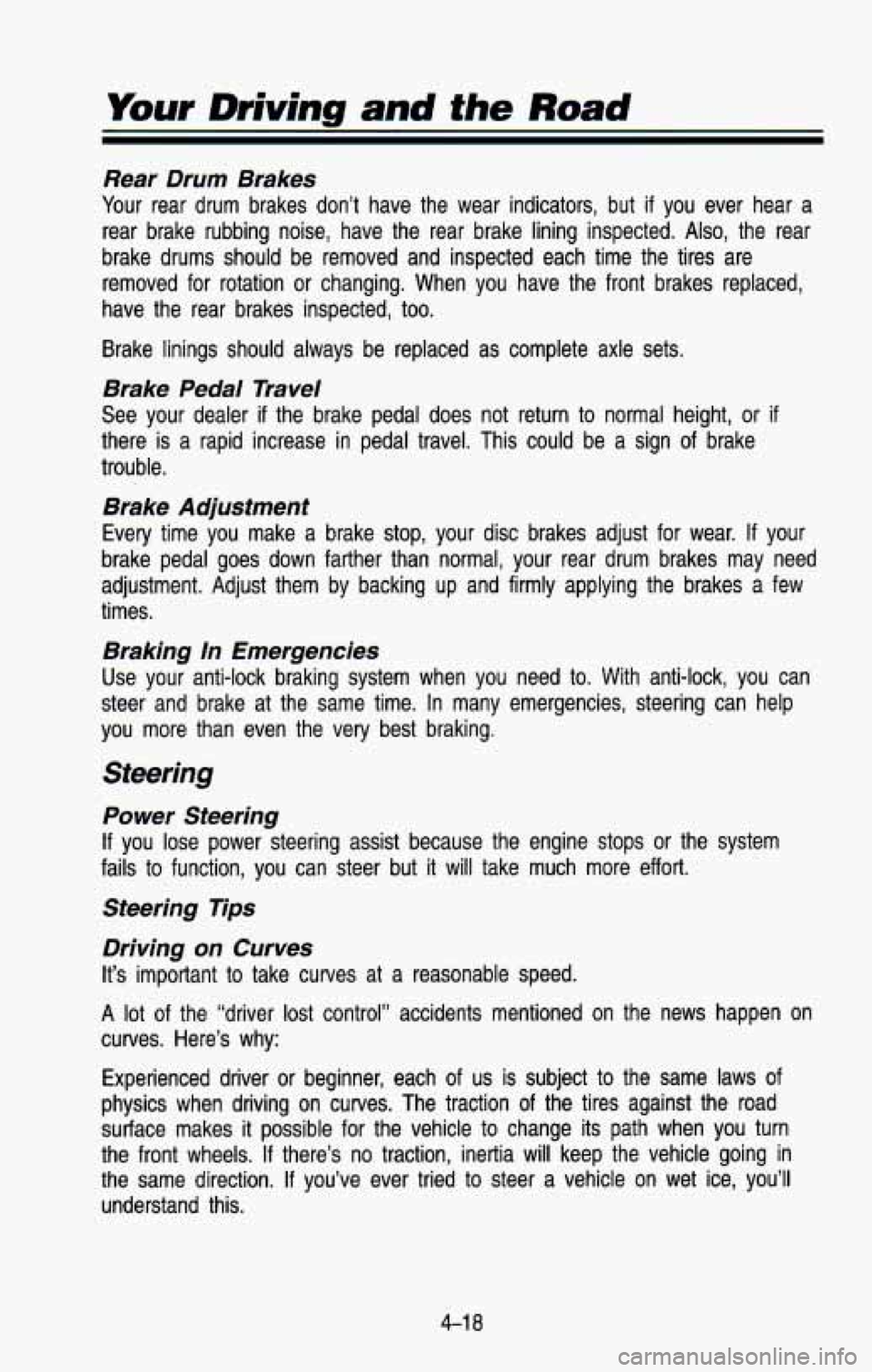
Your Driving and the Road
Rear Drum Brakes
Your rear drum brakes don’t have the wear indicators, but if you ever hear a
rear brake rubbing noise, have the rear brake lining inspected.\
Also, the rear
brake drums should be removed and inspected each time the tire\
s are removed for rotation or changing. When you have the front brak\
es replaced,
have the rear brakes inspected, too.
Brake linings should always be replaced as complete axle sets. \
Brake Pedal Travel
See your dealer if the brake pedal does not return to normal height, or if
there is a rapid increase in pedal travel. This could be a sign of brake
trouble.
Brake Adjustment
Every time you make a brake stop, your disc brakes adjust for\
wear. If your
brake pedal goes down farther than normal, your rear drum brak\
es may need
adjustment. Adjust them by backing up and firmly applying the brakes a few
times.
Braking In Emergencies
Use your anti-lock braking system when you need to. With anti-lock, you \
can
steer and brake at the same time. In many emergencies, steerin\
g can help
you more than even the very best braking.
Steering
Power Steering
If you lose power steering assist because the engine stops or the\
system
fails to function, you can steer but it will take much more effort.
Steering Tips
Driving on Curves
It’s important to take curves at a reasonable speed.
A lot of the “driver lost control” accidents mentioned on the n\
ews happen on
curves. Here’s why:
Experienced driver
or beginner, each of us is subject to the same laws of
physics when driving on curves. The traction of the tires against the road
surface makes
it possible for the vehicle to change its path when you turn
the front wheels.
If there’s no traction, inertia will keep the vehicle going in
the same direction.
If you’ve ever tried to steer a vehicle on wet ice, you’ll \
understand this.
4-1 8
Page 186 of 386
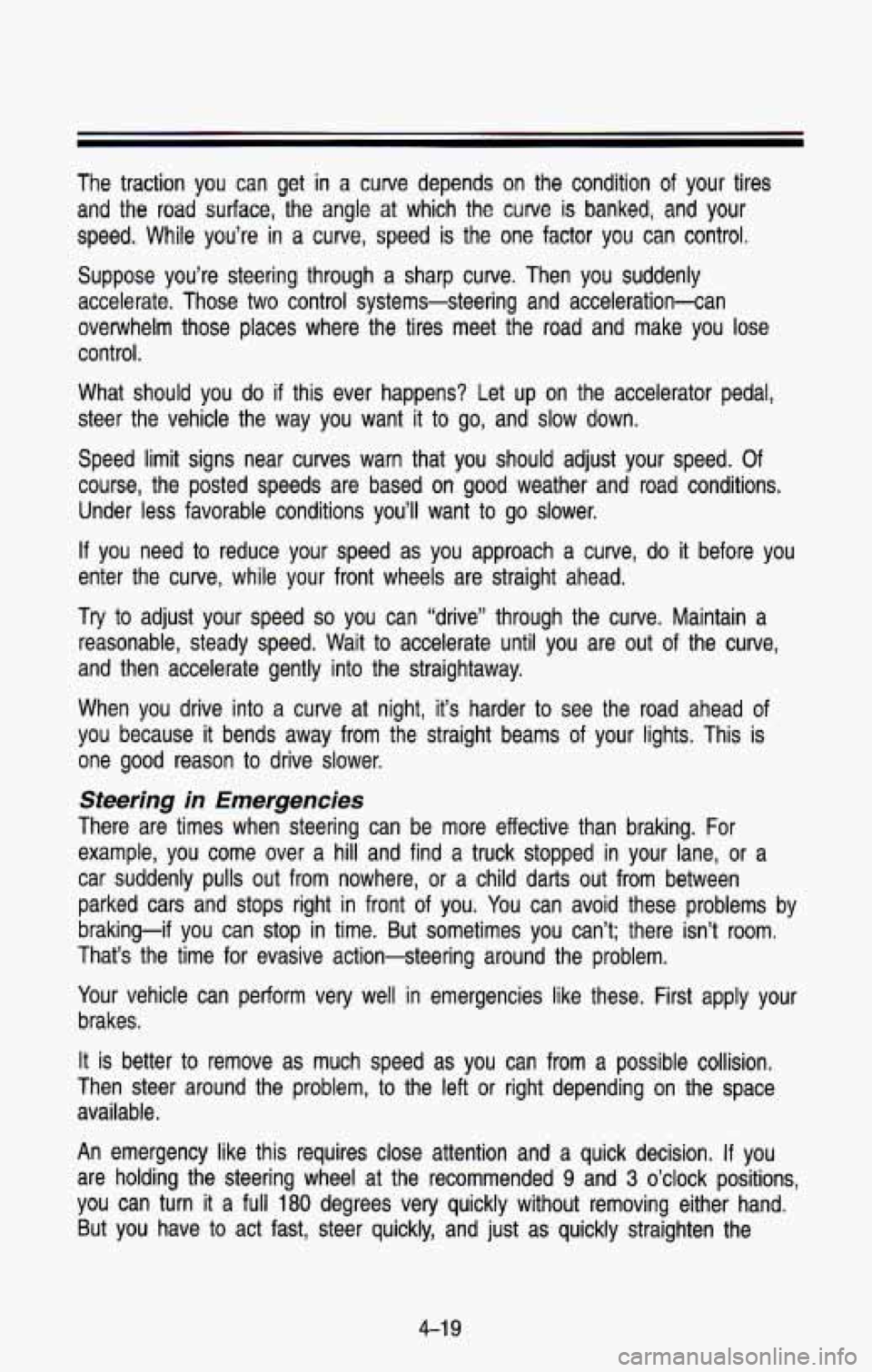
The traction you can get in a curve depends on the condition of your tires
and the
road surface, the angle at which the curve is banked, and your
speed. While you’re in
a curve, speed is the one factor you can control.
Suppose you’re steering through a sharp curve. Then you suddenly
accelerate. Those two control systems-steering and acceleration-ca\
n
overwhelm those places where the tires meet the road and make \
you lose
control.
What should you do if this ever happens? Let up on the accel\
erator peaal,
steer the vehicle the way you want it
to go, and slow down.
Speed limit signs near curves warn that you should adjust your\
speed. Of
course, the posted speeds are based
on good weather and road conditions.
Under less favorable conditions you’ll want
to go slower.
If you need to reduce your speed as you approach a curve, do it before you
enter the curve, while your front wheels are straight ahead.
Try to adjust your speed so you can “drive” through the curve. Maintain a
reasonable, steady speed. Wait to accelerate until
you are out of the curve,
and then accelerate gently into the straightaway.
When you drive into
a curve at night, it’s harder to see the road ahead of
you because it bends away from the straight beams
of your lights. This is
one
good reason to drive slower.
Steering in Emergencies
There are times when steering can be more effective than braki\
ng. For
example, you come over a hill and find a truck stopped in your lane, or a
car suddenly pulls out from nowhere,
or a child darts out from between
parked cars and stops right in front of you. You can avoid these problems by
braking-if you can stop in time. But sometimes you can’t; there isn’t room.
That’s the time for evasive action-steering around the proble\
m.
Your vehicle can perform very well in emergencies like these. First \
apply your
brakes.
It is better
to remove as much speed as you can from a possible collision.
Then steer around the problem, to the left or right depending \
on the space
available.
An emergency like this requires close attention and a quick decision.
If you
are holding the steering wheel at the recommended
9 and 3 o’clock positions,
you can turn it a full
180 degrees very quickly without removing either hand.
But you have
to act fast, steer quickly, and just as quickly straighten the
4-1 9
Page 187 of 386
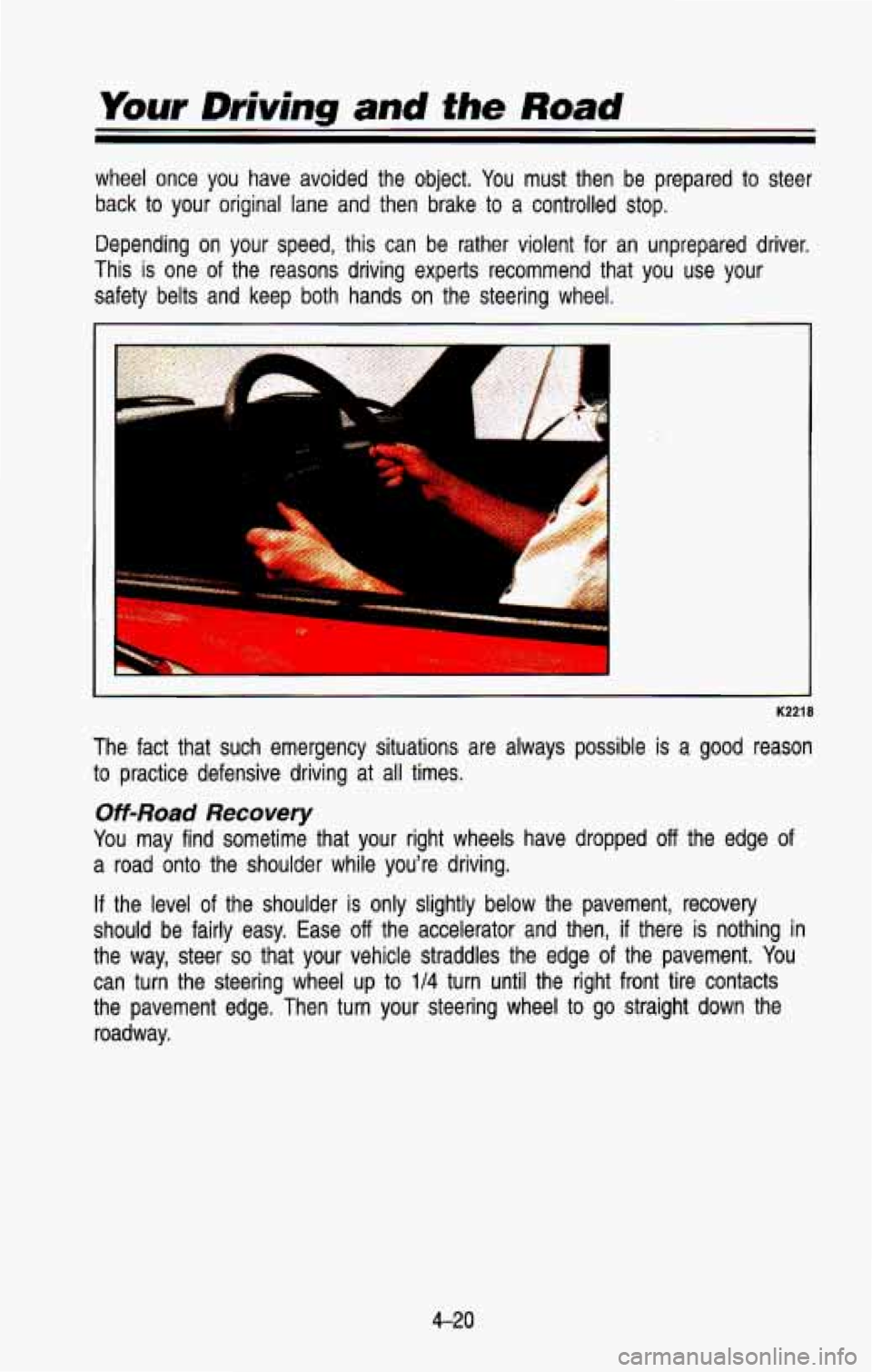
Your Driving and the Road
wheel once you have avoided the object. You must then be prep\
ared to steer
back to your original lane and then brake to a controlled stop.
Depending on your speed, this can be rather violent for an un\
prepared driver.
This is one
of the reasons driving experts recommend that you use your
safety belts and keep both hands on the steering wheel.
-
K2218
The fact that such emergency situations are always possible is a good reason
to practice defensive driving at all times.
Off-Road Recovery
You may find sometime that your right wheels have dropped off the edge of
a road onto the shoulder while you're driving.
If the level of the shoulder is only slightly below the pavement, recovery
should be fairly easy. Ease
off the accelerator and then, if there is nothing in
the way, steer
so that your vehicle straddles the edge of the pavement. You
can turn the steering wheel up to 1/4 turn until the right front tire contacts
the pavement edge. Then turn your steering wheel to go straight down the
roadway.
4-20
Page 190 of 386
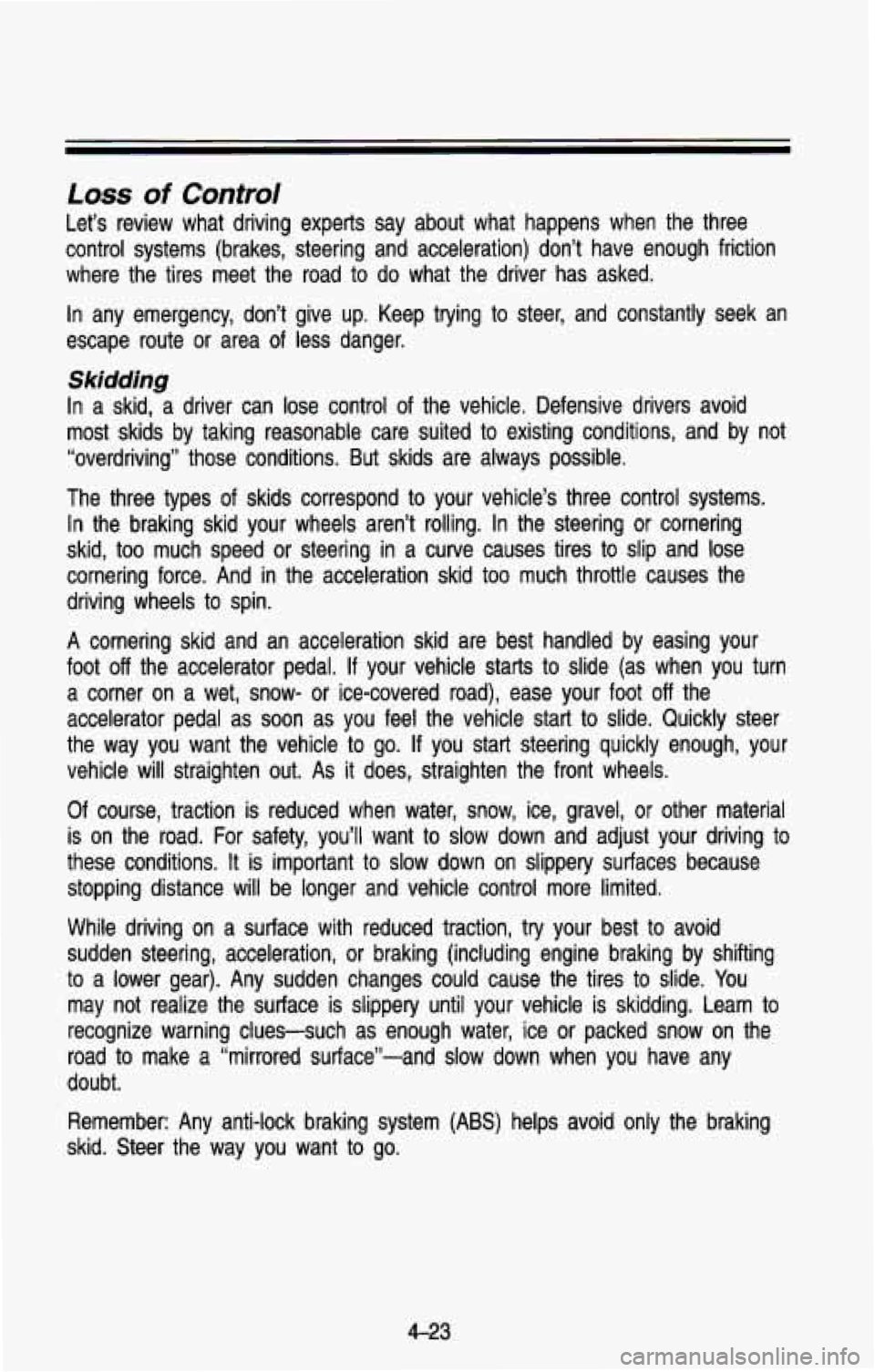
Loss of Control
Let’s review what driving experts say about what happens whe\
n the three
control systems (brakes, steering and acceleration) don’t ha\
ve enough friction
where the tires meet the road to do what the driver has asked.
In any emergency, don’t give up. Keep trying
to steer, and constantly seek an
escape route or area of less danger.
Skidding
In a skid, a driver can lose control of the vehicle. Defensive d\
rivers avoid
most skids by taking reasonable care suited
to existing conditions, and by not
“overdriving” those conditions. But skids are always possib\
le.
The three types of skids correspond
to your vehicle’s three control systems.
In the braking skid your wheels aren’t rolling. In the steering
or cornering
skid,
too much speed or steering in a curve causes tires to slip and lose
cornering force. And in the acceleration skid too much throttle causes the
driving wheels to spin.
A cornering skid and an acceleration skid are best handled by easing your
foot off the accelerator pedal. If your vehicle starts to slide (as when you turn
a corner on a wet, snow-
or ice-covered road), ease your foot off the
accelerator pedal as soon as you feel the vehicle start
to slide. Quickly steer
the way you want the vehicle
to go. If you start steering quickly enough, your
vehicle will straighten out. As it does, straighten the front wheels.
Of course, traction is reduced when water, snow, ice, gravel,
or other material
is on the road.
For safety, you’ll want to slow down and adjust your driving to
these conditions.
It is important to slow down on slippery surfaces because
stopping distance will be longer and vehicle control more limit\
ed.
While driving on a surface with reduced traction,
try your best to avoid
sudden steering, acceleration,
or braking (including engine braking by shifting
to a lower gear). Any sudden changes could cause the tires t\
o slide. You
may not realize the surface is slippery until your vehicle is \
skidding. Learn to
recognize warning clues-such as enough water, ice or packed snow on the
road to make a “mirrored surface”-and slow down when you have any\
doubt.
Remember: Any anti-lock braking system (ABS) helps avoid only the braking
skid. Steer the way you want
to go.
4-23
Page 193 of 386
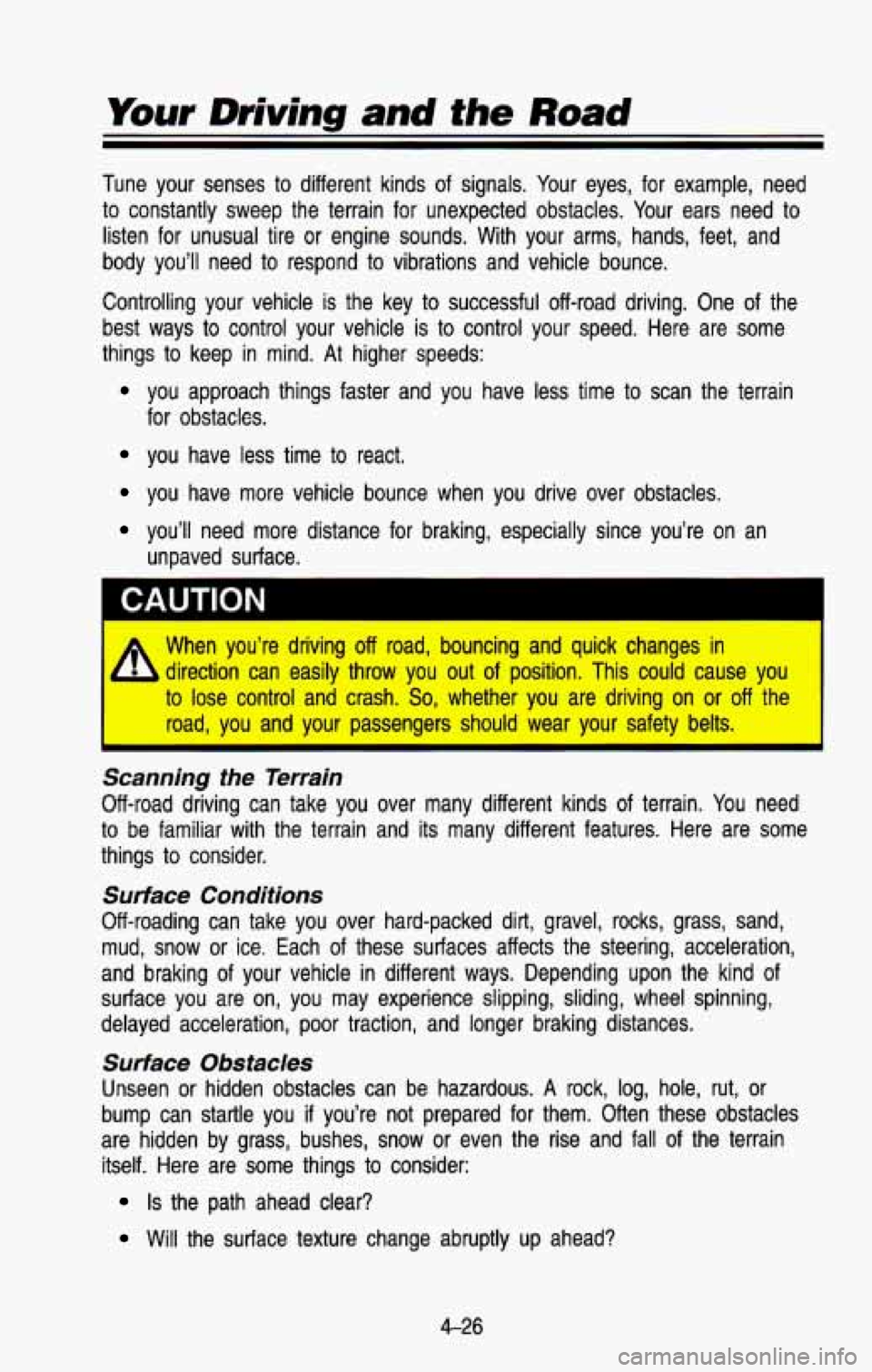
Your Driving and the Road
Tune your senses to different kinds of signals. Your eyes, for example, need
to constantly sweep the terrain for unexpected obstacles. Your ears need to
listen for unusual tire or engine sounds. With your arms, hand\
s, feet, and
body you’ll need to respond
to vibrations and vehicle bounce.
Controlling your vehicle is the key to successful off-road driving. One of the
best ways to control your vehicle
is to control your speed. Here are some
things to keep in mind.
At higher speeds:
you approach things faster and you have less time to scan the\
terrain
for obstacles.
you have less time to react.
you have more vehicle bounce when you drive over obstacles.
you’ll need more distance for braking, especially since you’\
re on an
unpaved surface.
A
When you’re driving off road, bouncing and quick changes in I
direction can easily throw you out of position. This could cause you
to lose control and crash.
So, whether you are driving on or off the
road, you and your passengers should wear your safety belts.
Scanning the Terrain
Off-road driving can take you over many different kinds of terrain. You need
to be familiar with the terrain and its many different features. Here are some
things to consider.
Surface Conditions
Off-roading can take you over hard-packed dirt, gravel, rocks, grass, sand,
mud, snow or ice. Each of these surfaces affects the steering, acceleration,
and braking of your vehicle in different ways. Depending upon the kind of
surface you are on, you may experience slipping, sliding, wheel spinning,
delayed acceleration, poor traction, and longer braking distances\
.
Surface Obstacles
Unseen or hidden obstacles can be hazardous. A rock, log, hole, rut, or
bump can startle you
if you’re not prepared for them. Often these obstacles
are hidden by grass, bushes, snow
or even the rise and fall of the terrain
itself. Here are some things to consider:
Is the path ahead clear?
Will the surface texture change abruptly up ahead?
4-26
Page 194 of 386
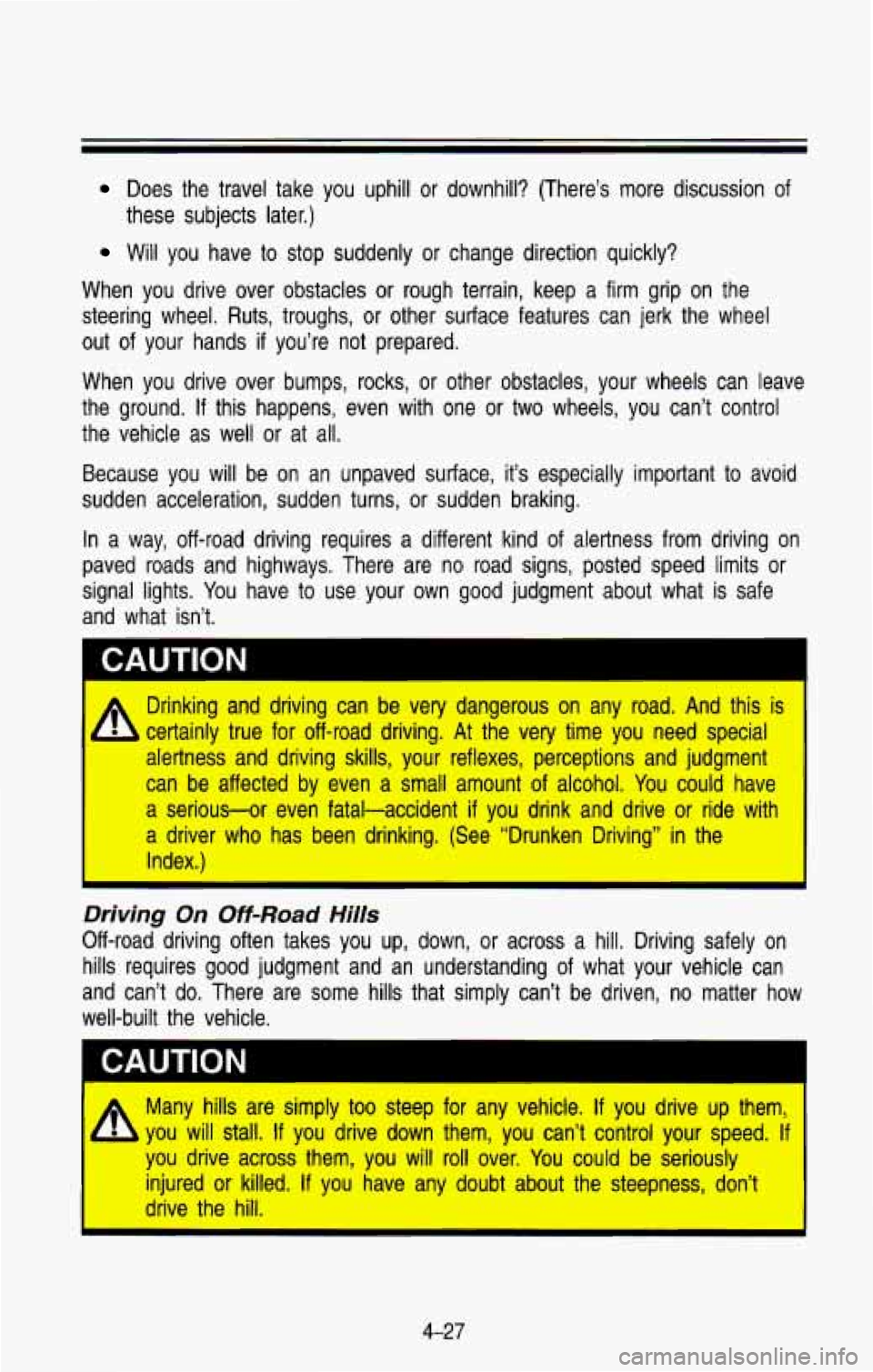
Does the travel take you uphill or downhill? (There’s more discussion of
these subjects later.)
Will you have to stop suddenly or change direction quickly?
When you drive over obstacles
or rough terrain, keep a firm grip on the
steering wheel. Ruts, troughs, or other surface features can jerk the wheel
out of your hands
if you’re not prepared.
When you drive over bumps, rocks, or other obstacles, your wheels can leave
the ground.
If this happens, even with one or two wheels, you can’t control
the vehicle as well or at all.
Because you will
be on an unpaved surface, it’s especially important to avoid
sudden acceleration, sudden turns, or sudden braking.
In a way, off-road driving requires a different kind of alertness from driving on
paved roads and highways. There are no road signs, posted spee\
d limits or
signal lights. You have to use your
own good judgment about what is safe
and what isn’t.
I CAUTION
Drinking and driving can be very dangerous on any road. And this is
- b certainly true for off-road driving. At the very time you need special
alertness and driving skills, your reflexes, perceptions and jud\
gment
can be affected by even a small amount
of alcohol. You could have
a serious-or even fatal-accident
if you drink and drive or ride with
a driver who has been drinking. (See “Drunken Driving” in the
Index.)
Driving On Oft-Road Hills
Off-road driving often takes you up, down, or across a hill. Driving safely on
hills requires good judgment and an understanding of what your vehicle can
and can’t do. There are some hills that simply can’t be driven, no matter how
well-built the vehicle.
I CAUTION
A Many hills are simply too steep for any vehicle. If you drive up them,
62 you will stall. If you drive down them, you can’t control your speed. If
you drive across them, you will roll over. You could be seriously
injured or killed.
If you have any doubt about the steepness, don’t
drive the hill.
4-27
Page 195 of 386
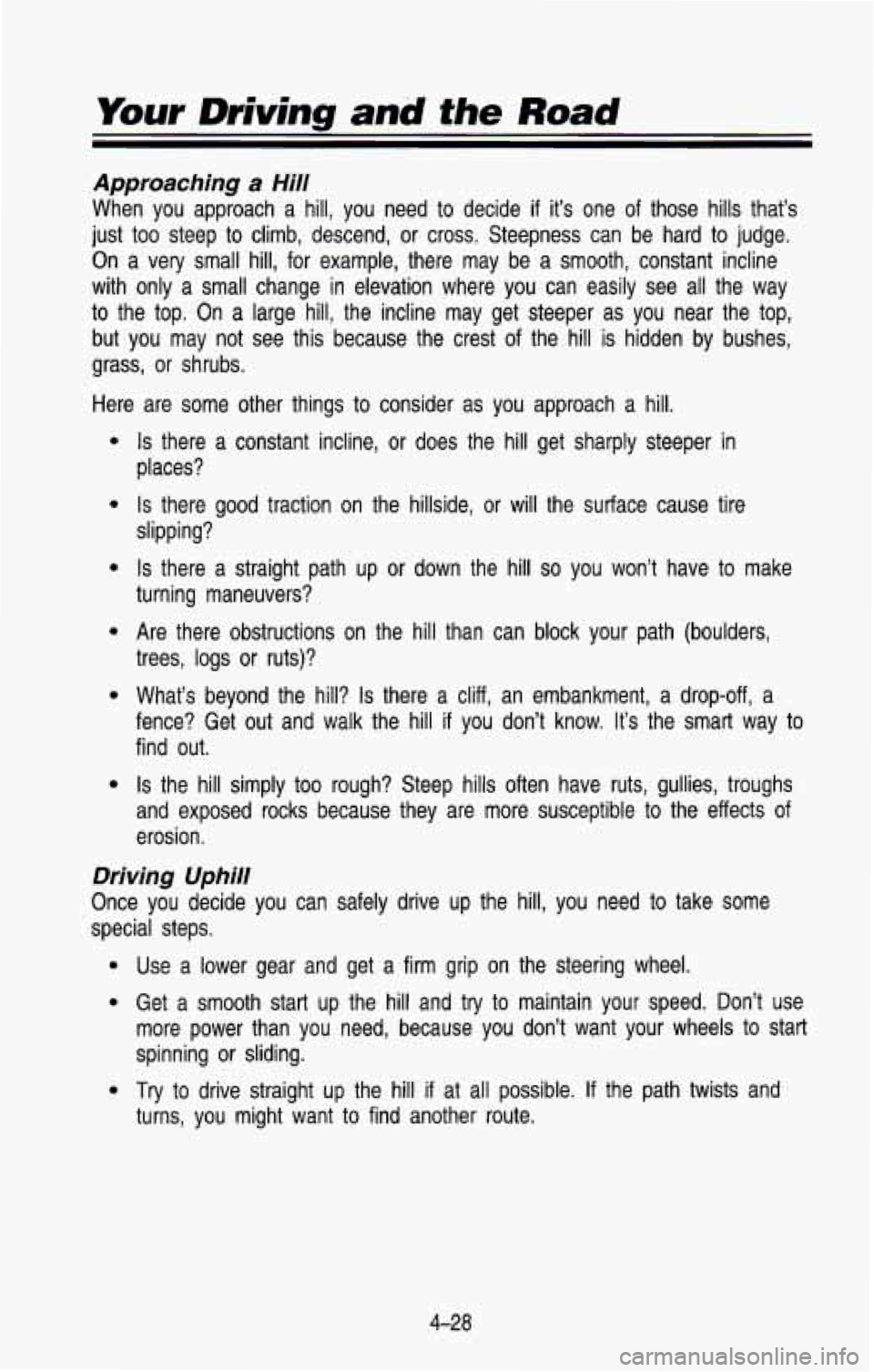
Your Driving and the Road
Approaching a Hill
When you approach a hill, you need to decide if it’s one of those hills that’s
just too steep to climb, descend, or cross. Steepness can be hard to judge.
On a very small hill, for example, there may be a smooth, constant incline
with only a small change in elevation where you can easily se\
e all the way
to the top. On a large hill, the incline may get steeper as you near the top,
but you may not see this because the crest of the hill is hidden by bushes,
grass, or shrubs.
Here are some other things to consider as you approach a
hill.
e
e
e
e
e
0
Is there a constant incline, or does the hill get sharply steeper\
in
places?
Is there good traction on the hillside, or will the surface cause tire
slipping?
Is there a straight path up
or down the hill so you won’t have to make
turning maneuvers?
Are there obstructions
on the hill than can block your path (boulders,
trees, logs or ruts)?
What’s beyond the hill? Is there a cliff, an embankment, a drop-off, a
fence? Get out and walk the hill
if you don’t know. It’s the smart way to
find out.
Is the hill simply too rough? Steep hills often have ruts, gu\
llies, troughs
and exposed rocks because they are more susceptible to the eff\
ects of
erosion.
Driving Uphill
Once you decide you can safely drive up the hill, you need to take some
special steps.
e
e
e
Use a lower gear and get a firm grip on the steering wheel. \
Get a smooth start up the hill and try to maintain your speed. Don’t use
more power than you need, because you don’t want your wheel\
s to start
spinning or sliding.
Try to drive straight up the hill if at all possible. If the path twists and
turns, you might want to find another route.
4-28
Page 196 of 386
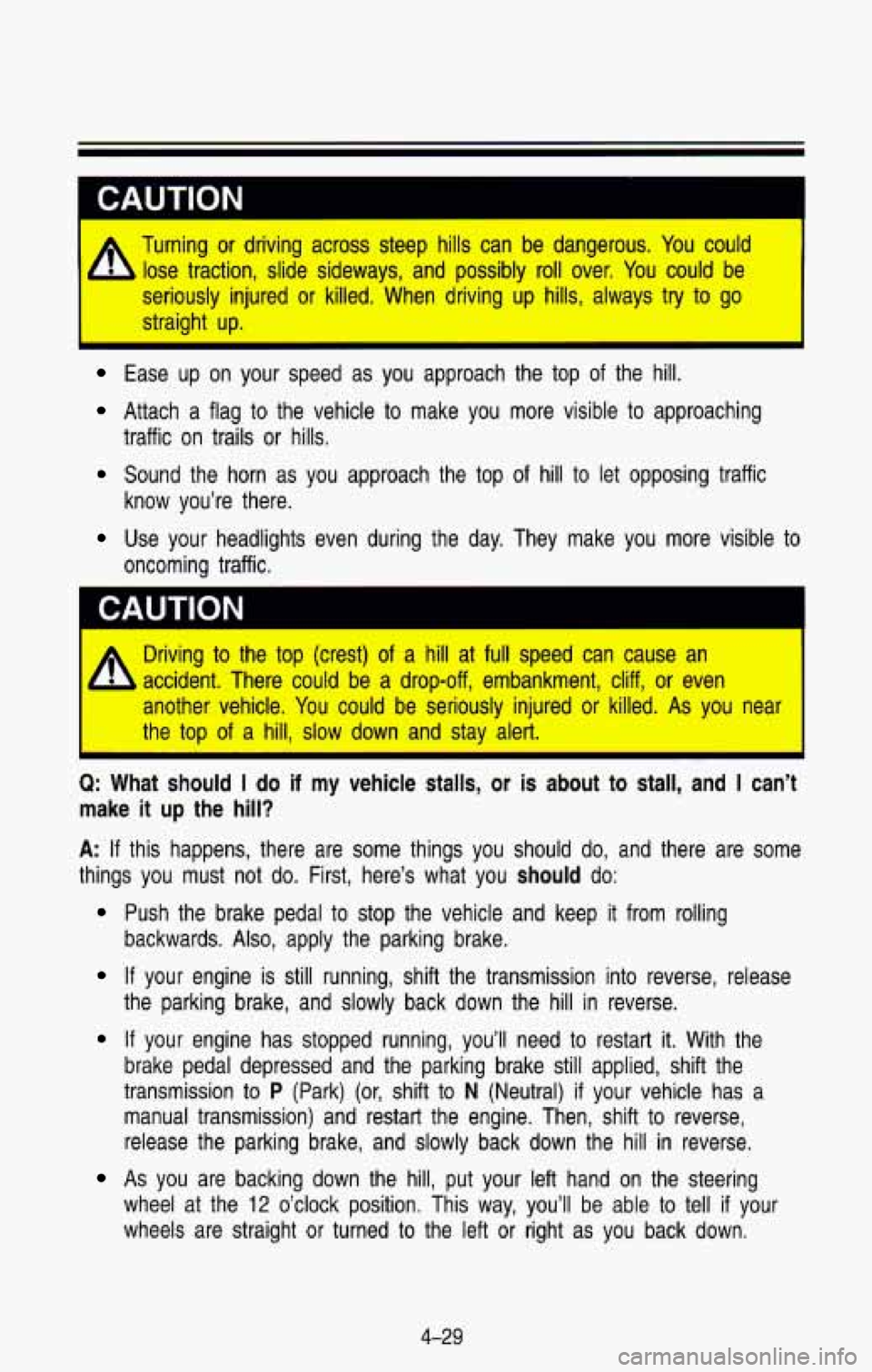
h
Turning or driving across steep hills can be dangerous. You could
lose traction, slide sideways, and possibly roll over. You could be
seriously injured or killed. When driving up hills, always try to
go
I straight up.
Ease up on your speed as you approach the top of the hill.
Attach a flag to the vehicle to make you more visible to approaching
Sound the horn as you approach the top of hill to let opposing traffic
Use your headlights even during the day. They make you more visible to
traffic on trails
or hills.
know you’re there.
oncoming traffic.
I CAUTION
’ rf Driving to the top (crest) of a hill at full speed can cause an
1 the top of a hill, slow down and stay alert.
ccident.
There could be a drop-off, embankment, cliff, or even
another vehicle. You could be seriously injured or killed.
As you near
Q: What should I do if my vehicle stalls, or is about to stall, and I can’t
make it up the hill?
A: If this happens, there are some things you should do, and there \
are some
things you must not do. First, here’s what you should do:
Push the brake pedal to stop the vehicle and keep it from rolling
backwards.
Also, apply the parking brake.
If your engine is still running, shift the transmission into reverse, release
the parking brake, and slowly back down the hill in reverse.
If your engine has stopped running, you’ll need to restart it. With the
brake pedal depressed and the parking brake still applied, shift the
transmission to
P (Park) (or, shift to N (Neutral) if your vehicle has a
manual transmission) and restart the engine. Then, shift
to reverse,
release the parking brake, and slowly back down the hill
in reverse.
As you are backing down the hill, put your left hand on the steering
wheel at the
12 o’clock position. This way, you’ll be able to tell if your
wheels are straight or turned to the left or right as you back down.
4-29